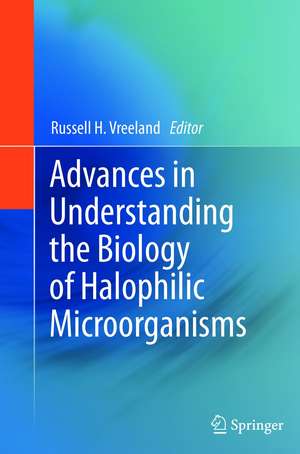Advances in Understanding the Biology of Halophilic Microorganisms
Editat de Russell H. Vreelanden Limba Engleză Paperback – 29 ian 2015
- reveal the background information about working with salt loving organisms,
- are loaded with information about how experiments are conducted under high salt,
- provide information about analyses that work under these conditions and those that may not,
- present a wide range of details from laboratory designs to equipment used and even to simple anecdotal hints that can only come from experience.
Microbiological training focuses largely on the growth, the handling and the study of the microbes associated with humans and animals. Yet the largest proportion of the Earth’s microbiota lives in saline environments such as the Oceans, saline deserts and terminal hypersaline environments. This need for salt can be intimidating for those interested in entering the field or for those interested in understanding how such research is accomplished.
| Toate formatele și edițiile | Preț | Express |
|---|---|---|
| Paperback (1) | 1091.85 lei 6-8 săpt. | |
| SPRINGER NETHERLANDS – 29 ian 2015 | 1091.85 lei 6-8 săpt. | |
| Hardback (1) | 1103.03 lei 6-8 săpt. | |
| SPRINGER NETHERLANDS – 14 dec 2012 | 1103.03 lei 6-8 săpt. |
Preț: 1091.85 lei
Preț vechi: 1149.32 lei
-5% Nou
Puncte Express: 1638
Preț estimativ în valută:
208.94€ • 219.70$ • 172.63£
208.94€ • 219.70$ • 172.63£
Carte tipărită la comandă
Livrare economică 17 aprilie-01 mai
Preluare comenzi: 021 569.72.76
Specificații
ISBN-13: 9789400798830
ISBN-10: 9400798830
Pagini: 252
Ilustrații: VIII, 241 p. 20 illus.
Dimensiuni: 155 x 235 x 13 mm
Greutate: 0.36 kg
Ediția:2012
Editura: SPRINGER NETHERLANDS
Colecția Springer
Locul publicării:Dordrecht, Netherlands
ISBN-10: 9400798830
Pagini: 252
Ilustrații: VIII, 241 p. 20 illus.
Dimensiuni: 155 x 235 x 13 mm
Greutate: 0.36 kg
Ediția:2012
Editura: SPRINGER NETHERLANDS
Colecția Springer
Locul publicării:Dordrecht, Netherlands
Public țintă
ResearchCuprins
1. Approaches toward the study of halophilic microorganisms in their natural environments: who are they and what are they doing?. - 2. Media and Conditions for the Growth of Halophilic and Halotolerant Bacteria and Archaea. - 3. Taxonomy of Halophilic Archaea and Bacteria. - 4. Halophilic Viruses. - 5. Microorganisms in Evaporites: A review of modern Geomicrobiology. - 6. Searching for microbes and DNA in ancient halite. - 7. DNA Replication and Repair in Halophiles. - 8. Gene Transfer Mechanisms, Population Genetics/Genomics and the Evolution of Haloarchaea. - 9. Worth Your Salt: Halophiles in Education. - 10. Halophiles in the Public Media.
Textul de pe ultima copertă
Saline environments are one of the most plentiful and interesting types of habitats on Earth and are often considered as models for potential life on other planets or moons. The hypersaline playas, sabkhas, salterns, lakes, soils and even crystals often contain biomass that is far in excess of what might be predicted from the environmental conditions alone. The populations become so dense they color the brines and have been noticed by humanity since 2500 BC. In addition much of planet Earth is underlain by vast ancient salt deposits that may be thousands of meters thick and stretch for many kilometers. Even deep within the Earth’s crust there are vast reservoirs of saline water all of which contain salt loving microbes. These are not however simple terminal ecosystems. These saline habitats literally team with a complex web of life containing large populations of salt loving bacteria, archaea, algae, viruses and even fungi. Halophilic microorganisms are one of the more fascinatingmicrobial groups known today. Their ability to exist in exceptionally high salt (as NaCl) brines, soils and even in ancient halite provides a wide array of areas for physiological, ecological and molecular studies. Whenever media reports present something on salt loving microbes there is intense public interest and fascination. The scientists that begin to study halophiles never stop.
This book is an update of one originally published in 1992. Many of the topics covered are the same but others are new and reflect more modern approaches. This book is not a series of reviews of topics. It is more than that.
This book is an update of one originally published in 1992. Many of the topics covered are the same but others are new and reflect more modern approaches. This book is not a series of reviews of topics. It is more than that.
Caracteristici
The development of halophilic geomicrobiology using underground halite How to identify the best, most pristine salt crystals How to conduct field research on hypersaline microbes and viruses The use of halophilic microbes in education The application of population genetics to understand hypersaline microbial communities Includes supplementary material: sn.pub/extras Includes supplementary material: sn.pub/extras















